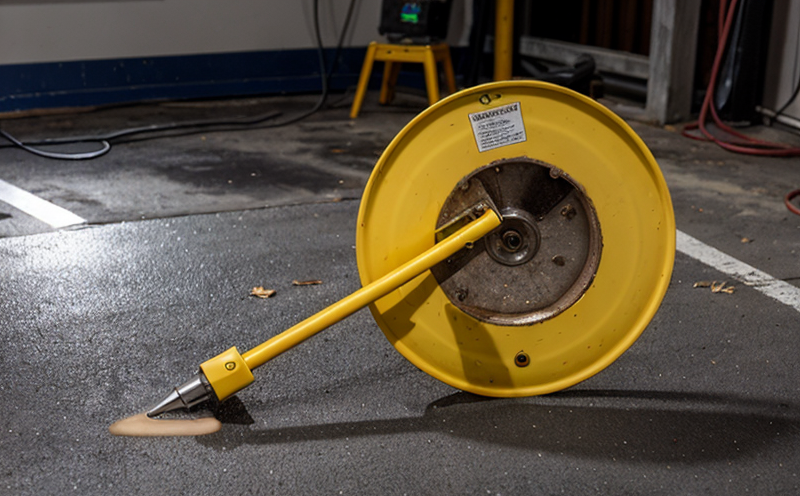ISO 5579 Radiographic Testing of Metallic Materials
The ISO 5579 standard provides a framework for the radiographic examination of metallic materials to ensure compliance with specific quality and safety requirements. This non-destructive evaluation (NDE) method is widely used in industries such as aerospace, automotive, and manufacturing where critical components must be inspected without altering their integrity.
Radiography involves passing X-rays or gamma rays through a metal component at various angles and recording the resulting images on film or digital media. The technique allows for the detection of internal defects such as cracks, porosity, lack of fusion, and other flaws that can compromise the structural integrity of parts made from metallic materials.
The process begins with detailed planning, including selecting the appropriate radiation source based on the thickness of the material to be inspected. For instance, thicker sections may require a higher energy source like cobalt-60, while thinner components might use a lower-energy source such as an X-ray machine. The radiographic setup is then calibrated according to ISO 5579 standards to ensure consistent and repeatable results.
Specimen preparation for radiography involves ensuring that the component is clean and free from contaminants that could interfere with the imaging process. This includes degreasing, cleaning, and sometimes etching surfaces to enhance contrast. The specimen is then positioned in a suitable holder and exposed to radiation, capturing multiple images at different angles.
After acquisition, the radiographs are processed according to ISO 5579 guidelines. This includes developing the film or digitizing the image for further analysis. Visual interpretation of these images by qualified personnel identifies defects based on their appearance, size, and location within the material. Defects can be classified into categories such as linear discontinuities, planar discontinuities, and volumetric discontinuities.
The acceptance criteria for radiographic testing are strictly defined in ISO 5579 to ensure consistency across different laboratories. These criteria specify acceptable levels of defects based on the material type, thickness, and application area. Compliance with these standards is crucial for manufacturers to meet regulatory requirements and customer expectations.
In summary, ISO 5579 radiographic testing plays a vital role in ensuring the quality and safety of metallic components used in high-stress environments. By adhering to this standard, laboratories can provide reliable, consistent inspection results that contribute significantly to product reliability and safety.
Benefits
The implementation of ISO 5579 radiographic testing offers numerous advantages for manufacturers and quality control departments:
- Non-Destructive Inspection: Ensures that components remain intact after inspection, preserving their usability.
- Informed Decision-Making: Provides detailed insights into the internal integrity of materials, aiding in informed decisions about product reliability.
- Regulatory Compliance: Meets stringent international standards ensuring legal and safety requirements are met.
- Cost Efficiency: Identifies defects early in the manufacturing process reducing costly rework or scrapping of defective parts.
The benefits extend beyond immediate quality assurance to long-term reliability and brand reputation. By adhering to ISO 5579, organizations can enhance their competitive edge by demonstrating a commitment to excellence in product quality.
Competitive Advantage and Market Impact
The adoption of ISO 5579 radiographic testing provides significant competitive advantages for manufacturing companies. In an increasingly globalized market, adherence to international standards like ISO can differentiate a company from its competitors by showcasing commitment to quality and safety.
Manufacturers who invest in advanced NDE methods such as ISO 5579 radiography are better positioned to secure contracts with demanding clients, particularly those in sectors where product reliability is paramount. For instance, aerospace manufacturers must meet stringent regulatory requirements to ensure the safety of aircraft components. By demonstrating compliance with ISO standards, companies can gain a competitive edge.
The use of advanced testing techniques also facilitates smoother supply chain management by ensuring that only high-quality materials and components are used. This not only enhances product reliability but also supports sustainable business practices, which are increasingly valued by consumers and regulatory bodies.
Moreover, the implementation of ISO 5579 radiographic testing contributes to a company's long-term reputation for quality and safety. In an era where brands face scrutiny from various stakeholders, demonstrating adherence to international standards can significantly bolster customer trust and loyalty.
Use Cases and Application Examples
| Component Type | Radiographic Testing Application | Industry Sector |
|---|---|---|
| Aircraft Engine Blades | Detection of cracks and porosity | Aerospace |
| Battery Cells | Assessment of internal structure integrity | Electronics & Energy Storage |
| Pressure Vessels | Evaluation of welds and structural integrity | Oil & Gas |
| Turbine Blades | Inspection for internal defects | Aerospace |
- Aircraft Engine Blades: Radiographic testing is critical in identifying cracks and porosity, ensuring the safe operation of aircraft engines.
- Battery Cells: Assessment of internal structure integrity helps prevent failures that could lead to safety hazards.
- Pressure Vessels: Evaluation of welds and overall structural integrity ensures compliance with safety regulations.
- Turbine Blades: Inspection for internal defects is essential in the aerospace industry to maintain operational reliability.
In each case, ISO 5579 radiographic testing provides a reliable method for ensuring that critical components meet the highest quality and safety standards.





